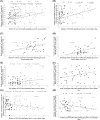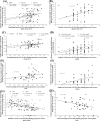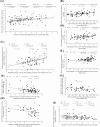The search for yield predictors for mature field-grown plants from juvenile pot-grown cassava (Manihot esculenta Crantz)
- PMID: 32374747
- PMCID: PMC7202627
- DOI: 10.1371/journal.pone.0232595
The search for yield predictors for mature field-grown plants from juvenile pot-grown cassava (Manihot esculenta Crantz)
Abstract
Cassava is the 6th most important source of dietary energy in the world but its root system architecture (RSA) had seldom been quantified. Ability to select superior genotypes at juvenile stages can significantly reduce the cost and time for breeding to bridge the large yield gap. This study adopted a simple approach to phenotyping RSA traits of juvenile and mature cassava plants to identify genotypic differences and the relationships between juvenile traits and harvest index of mature plants. Root classes were categorised and root and shoot traits of eight (8) juvenile pot-grown cassava genotypes, were measured at 30 and 45 days after planting (DAP). The same or related traits were measured at 7 months after planting of the same genotypes grown in the field while yield and yield components were measured in 12-months old field-grown plants. The field experiment was done in 2017 and repeated in 2018. Differences between genotypes for the measured traits were explored using analysis of variance (ANOVA) while traits in juvenile plants were correlated or regressed onto traits measured in 7- and 12-months old plants. The results show significant genotypic variations for most of the traits measured in both juvenile and 7-months old plants. In the 12-months old plants, differences between genotypes were consistent for both 2017 and 2018. Broad-sense heritability was highest for the number of commercial roots (0.87) and shoot fresh weight (0.78) and intermediate for the total number of roots (0.60), harvest index (0.58), fresh weight of roots (0.45). For all the sampling time points or growth stages, there were greater correlations between traits measured at a particular growth stage than between the same traits at different growth stages. However, some juvenile-mature plant trait relationships were significant, positive and consistent for both 2017 and 2018. For example, total root length and the total number of roots in 30 DAP, and branching density of upper nodal roots in 45 DAP, positively correlated with harvest index of 12-months old plants in both 2017 and 2018. Similarly, the diameter of nodal roots, for example, had a negative, significant correlation with fresh shoot biomass of mature plants in both 2017 and 2018. Regression of traits measured in 30 DAP explained up to 22% and 36% of the variation in HI of mature plants in 2017 and 2018, respectively. It is concluded that the simple, rapid, inexpensive phenotyping approach adopted in this study is robust for identifying genotypic variations in juvenile cassava using root system traits. Also, the results provide seminal evidence for the existence of useful relationships between traits of juvenile and mature cassava plants that can be explored to predict yield and yield components.
Conflict of interest statement
The authors have declared that no competing interests exist.
Figures







Similar articles
-
Causal shoot and root system traits to variability and plasticity in juvenile cassava (Manihot esculenta Crantz) plants in response to reduced soil moisture.Physiol Mol Biol Plants. 2020 Sep;26(9):1799-1814. doi: 10.1007/s12298-020-00865-4. Epub 2020 Aug 26. Physiol Mol Biol Plants. 2020. PMID: 32943817 Free PMC article.
-
Characterising shoot and root system trait variability and contribution to genotypic variability in juvenile cassava (Manihot esculenta Crantz) plants.Heliyon. 2018 Jun 28;4(6):e00665. doi: 10.1016/j.heliyon.2018.e00665. eCollection 2018 Jun. Heliyon. 2018. PMID: 30003159 Free PMC article.
-
Construction of an ultrahigh-density genetic linkage map for Manihot esculenta Crantz and identification of QTL for root quantity traits.BMC Plant Biol. 2025 Apr 25;25(1):534. doi: 10.1186/s12870-025-06278-3. BMC Plant Biol. 2025. PMID: 40281418 Free PMC article.
-
The Cassava Source-Sink project: opportunities and challenges for crop improvement by metabolic engineering.Plant J. 2020 Aug;103(5):1655-1665. doi: 10.1111/tpj.14865. Epub 2020 Jun 26. Plant J. 2020. PMID: 32502321 Review.
-
Cassava biology and physiology.Plant Mol Biol. 2004 Nov;56(4):481-501. doi: 10.1007/s11103-005-2270-7. Plant Mol Biol. 2004. PMID: 15669146 Review.
Cited by
-
Causal shoot and root system traits to variability and plasticity in juvenile cassava (Manihot esculenta Crantz) plants in response to reduced soil moisture.Physiol Mol Biol Plants. 2020 Sep;26(9):1799-1814. doi: 10.1007/s12298-020-00865-4. Epub 2020 Aug 26. Physiol Mol Biol Plants. 2020. PMID: 32943817 Free PMC article.
References
-
- MoFA. Agriculture in Ghana Facts and Figures (2010) Ministry of Food and Agriculture, Statistics, Research and Information Directorate (SRID). 2011.
-
- Parkes EY, Allotey DF, Akuffo EA. Yield Performance of five cassava genotypes under different fertilizer rates. International Journal of Agricultural Sciences. 2012. May 1;2(5):iv+-173.
-
- Safo‐Kantanka O, Owusu‐Nipah J. Cassava varietal screening for cooking quality: relationship between dry matter, starch content, mealiness and certain microscopic observations of the raw and cooked tuber. Journal of the Science of Food and Agriculture. 1992;60(1):99–104.
-
- Spencer DS, Ezedinma C. Cassava cultivation in sub-Saharan Africa In Achieving sustainable cultivation of cassava Volume 1 2017. pp. 141–157. Burleigh Dodds Science Publishing.
MeSH terms
LinkOut - more resources
Full Text Sources
Miscellaneous

